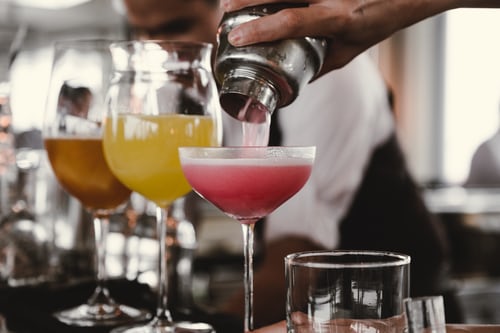It’s 2020, and we’re welcoming in a new decade. However, many of us are also hearkening back to a hundred years ago, what are commonly referred to as the “roaring twenties”. This era in American history is well-known for being the decade of jazz and speakeasies, with The Great Gatsby playing at the forefront of many people’s minds. But what did they eat and drink a hundred years ago? How much have food trends changed? And perhaps most importantly, what should you serve or expect to be served at a 1920’s-themed party this year?
Orange juice was popular in the 1920’s, which isn’t so different from today. In The Great Gatsby, Gatsby himself orders large quantities of oranges to be freshly squeezed for his parties. This decade was also known for its excess, since World War I had only recently ended, and with it the exhortations to conserve food for the troops. During the war, which America joined in 1917 and lasted until 1918, efforts to ration food had created trends like Meatless Mondays and Wheatless Wednesday, where families would try to abstain from eating certain foods. This sounds pretty familiar to some of the dieting and conservation efforts taking place today, with recipes designed specifically to avoid meat or other foods (either for health reasons or environmental concerns).
In a cookbook from the era, The Fifty-Two Sunday Dinners, one meal suggestion included baked ham, boiled carrots and peas, clam broth, potatoes with cheese, fried cauliflower, stuffed celery, walnut bread and custard for dessert. This menu is a little more intricate than many contemporary dinners, but most of the food items themselves are fairly standard for our day and age. Canned foods were now becoming accessible, as canning had become a convenient method of storing and transporting food to troops during World War I. Fruits and vegetables started to be featured more in people’s diets since produce could be available out-of-season with the boom of canned foods.
But this doesn’t exactly mean that the 1920’s was a healthy time. Take a look at these products created during this decade: Wonder Bread, Baby Ruth candy bars, Popsicles, Hostess cakes and Kool-Aid. Oh, and don’t forget Velveeta. Technology was making food more processed and more convenient, which had both pros and cons for the people living in the 20s. Our age faces similar problems; with our busy lifestyle, especially those of us who are students, convenient food often works better for our schedules and processed foods are often cheaper, but neither of these factors positively impact our health.
Okay, but let’s be honest, 20’s parties probably aren’t going to be serving canned peas. So how do people today usually reinterpret roaring twenties’ food and drinks for today’s palates and expectations?
Cocktails and/or mocktails are usually standard for the occasion. In the roaring twenties, speakeasies served the majority of the illegal alcohol produced during the Prohibition era. However, bathtub gin wasn’t exactly the tastiest alcohol out there, so cocktails rose in popularity to cover up the flavor of the poor quality alcohol. Some common cocktails of the era include mint juleps and Sidecars, and there are dozens of twenties-inpsired mocktails online as well.
Deviled eggs are still in style, though not quite as beloved as back in the 1920’s. Anybody out there put paprika on deviled eggs? Well, so did the Americans a hundred years ago, thanks to the Hungarian immigrants who popularized the spice. Pastry pigs were also mentioned in The Great Gatsby, though most people nowadays would call them pigs in a blanket. Jello was a big deal; some jello desserts involved layering different colored jellos in a rainbow, and others incorporated pieces of fruit or other ingredients into the jello mold. Aspics were also served in the 20s, which is a savory version of jello, often with chicken and vegetables inside. It’s unlikely that any party this decade will be serving up an aspic, but an adventurous host might just surprise you. One more staple of the period was macaroni and cheese, which many people don’t necessarily associate with the 20’s. However, almost every cookbook contained a recipe for it, so it really does seem to be a popular dish of the time.
Food has changed a lot over the past one hundred years, but there are still plenty of surprising similarities. If you’re celebrating the new year, raise a glass of orange juice and hope that meat jello doesn’t come your way.

